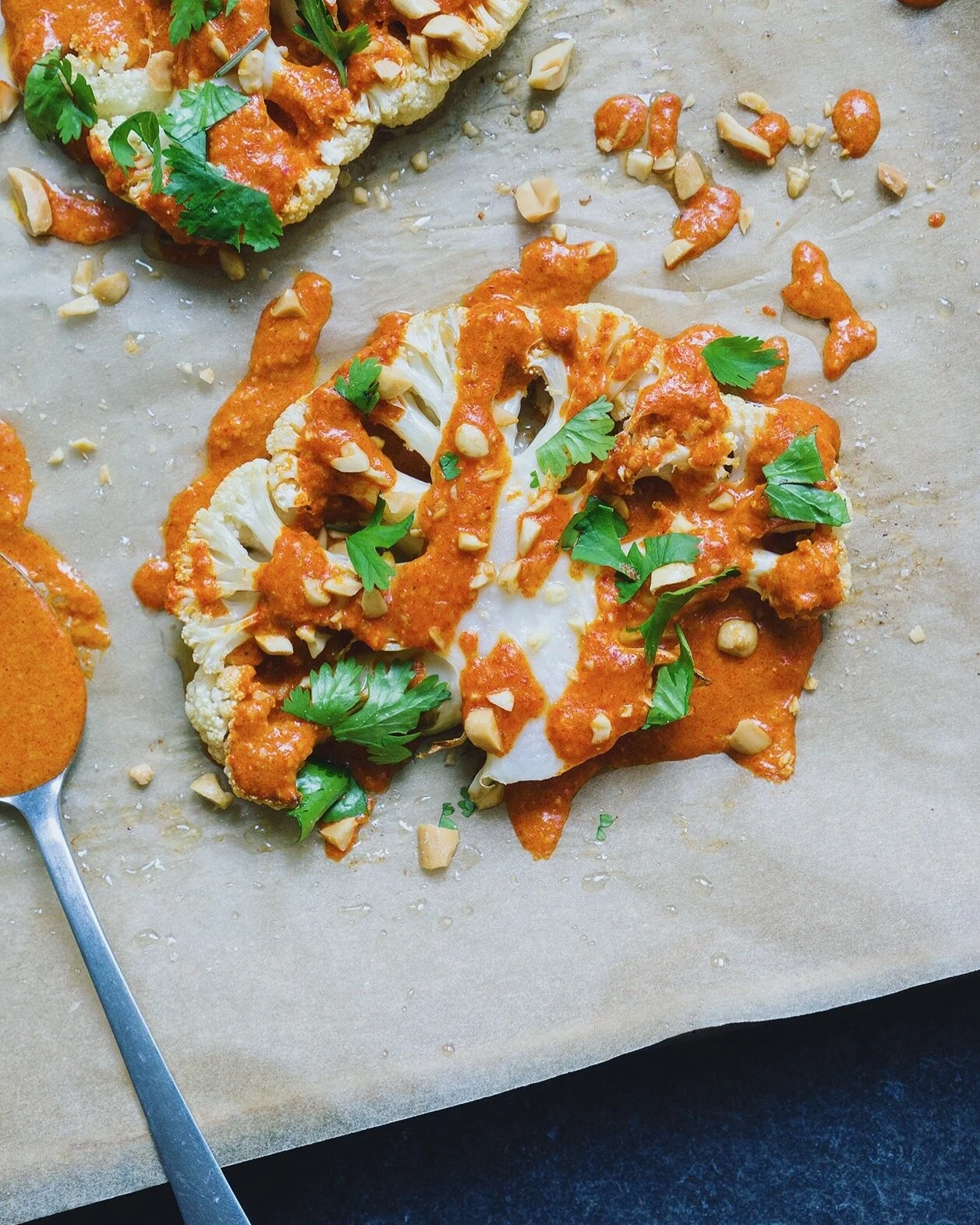This vegan side is exactly as it sounds—cauliflower sliced into flat steaks that you can grill, roast, or pan-fry.
Read MoreThis carrot and mint salad is one of those easy appetizers I'll make on hot summer days, to go with some fried rice or noodles.
Read MoreI went food shopping last week fully intending to make a hearty Thai chicken or pork curry for dinner. Then I saw all these eggplants and my intentions went out the window.
I realized I didn't cook with eggplants often enough. There were only two dishes in my repertoire that utilized eggplants, ratatouille and Sichuan "Fish-Fragrant" Eggplant. It was about time to add a third, especially when sitting inches away from the eggplants was a bin of gorgeous Thai basil bunches.
This recipe is so quick and easy to throw together that it can become a weeknight standby. The eggplant takes only about 9 or 10 minutes to cook, and it acts as a sponge for the tasty sauce of red curry paste, garlic, ginger, coconut milk, fish sauce and brown sugar. You can also make the dish fully vegetarian by substituting soy sauce for the fish sauce, but I love the earthiness that the fish sauce adds. The Thai basil goes in towards the end, but lends a great deep flavor to the rest of the dish.
Read More
Spice up your mussels with this delicious Thai Red Curry and coconut broth.
Read MoreRemember my Thai Basil Sangria post from a couple months ago, in which I became excited by the prospect of being able to grow herbs indoors during the winter? Well, that excitement might have been premature.
In early November sun was still streaming in through the windows for 8+ hours a day. It was still warm enough that I was able to crack open the window to let in fresh air. Not anymore, on both accounts. And my window plants, consequently, have been fading, even with religious watering.
All my herbs, including the Thai basil plant that was so lively before, are nearing the end. So for lunch one day, I decided to use up as much of it as possible while it was still somewhat healthy. I didn't want to trek to the store to pick up curry paste, so this Thai basil chicken fried rice was the answer. And it made me wonder why I didn't make fried rice with Thai basil more often. I used up not only most of the basil but also some leftover chicken in the fridge. Best of all, I spent only 5 minutes in front of the stove for a very tasty lunch.
Read MorePork salad! If these two words make you perk up at your desk, please read on.
[But before I begin, an apology first to anyone who has used the "Contact Me" form in the past couple of months. It had been broken for a while before a vigilant reader got a hold of me through Facebook and I realized this error. (And I've always wondered, when using contact forms myself on other websites over the years, if messages just disappeared into a black hole because of coding errors.) So I got rid of the form, but still want to hear from you guys! From now on, just email me at appetiteforchina (at) gmail (dot) com with any questions or comments.]
Now on to the salad. I first learned how to make larb mu (also spelled laap mu, larb moo, laap moo, etc.) from my friend Sandra, who taught cooking classes with me at the Hutong in Beijing. When we met, she already had already built an impressive globetrotting life, having lived and worked (mostly for NGOs) in Haiti, Vietnam, Taiwan, and mainland China, with Afghanistan soon to follow. In her spare time she made a habit of sniffing out the best local restaurants and street food wherever she was, and developed a ravenous curiosity for ingredients and techniques. Lucky for me, she had also spent a good amount of time traveling in Thailand and Laos, where this salad comes from (it originated in Laos and spread to Northern Thailand). After Sandra taught her Thai cooking class at the Hutong and made 4 pounds' worth of larb mu, I couldn't stop talking about the salad for weeks.
Over the years it's become an standby for whenever I crave Northern Thai food and want it fast.
Read MoreThese days, over the course of a typical week, I bring home and cook about five pounds of meat and seafood. This may not seem like much for a family of four, but when you're one person testing and retesting full recipes for a cookbook, it amounts to a lot of carnivorous consumption a week. (Leftovers, of course, are cheerfully shared.)
Meat is great and all, but sometimes you just crave vegetables for a meal.
It's not that my cookbook has no vegetarian recipes, but as far as Chinese food goes, almost all of the most beloved dishes involve meat or seafood in some form or another. In both China and the US, all-vegetable soups often have a base of pork or chicken stock. Vegetarian stir-fries and tofu dishes sometimes have dried shrimp or ground pork as flavor enhancers. The only vegetarians you are likely to find in China are Buddhist monks.
Read MoreLast week I helped out at a Thai cooking class at The Hutong taught by my friend Sandra of Savour Asia. As we sat down to a meal of mango salad, pork laap, and red curry chicken, I realized how much I missed having lemongrass as a kitchen staple. In New York I could easily take the train to Chinatown whenever I wanted to cook with lemongrass. In Beijing, Sanyuanli market has several stalls selling the aromatic stalky grass, but is such a trek from my apartment that it doesn't enter my cooking consciousness at a moment's notice.
After scooping the last of my laap mu into my mouth, I decided I must must must get lemongrass that day and make iced tea. Lemongrass and ginger iced tea is my drink of choice with Thai food if I want something lighter than iced tea with condensed milk. A somewhat long trip to Sanyuanli later, I had four stalks of fresh lemongrass to take guilty whiffs of and inspire bleary yearnings for a trip to Thailand this winter.
Read MoreMy search for quick vegetarian dishes continues. Going out 3 nights in a row with our vegetarian friends from London has convinced me that while it's a bit inconvenient to go meatless in China, it's not impossible. While I'm not considering becoming a strict vegetarian, my conscience dictates that eating more vegetable and grains and having meat only once or twice a week is better for good ol' planet Earth. (The conscience thing I can blame on Fast Food Nation, this Michael Pollan article, and having lived in gentrified Brooklyn, which probably has the highest concentration of vegetarians outside India and San Francisco.)
Pad See-Ew is a Thai noodle dish that can be made with meat or without. (Some people call it Thai-Chinese, because the technique of stir-frying noodles came from Chinese immigrants.) It's a lot like the Cantonese chow hor fun, with thicker sauce and the addition of egg. I have had it countless times in Thai restaurants, but never thought to make at home until I came across Blazing Hot Wok's recipe from earlier this year. This dish has fewer ingredients than Pad Thai and is easier to make, perfect for those lazy "crap, I'm starving but my fridge is practically empty" days.
If you don't have omnivore guilt like I do, feel free to throw in chicken, pork, even shrimp. BHW emphasizes that the main ingredient is mushroom-flavored soy sauce, which can be found in Chinese markets (I believe Lee Kum Kee) makes one. However, I've found that soaking dry shiitake mushrooms in soy sauce for about an hour, while periodically squeezing the juices out, gives a similar umami effect. If you're using flat rice noodles instead of fresh, soak them for about 20 minutes to soften before stir-frying.
Read More


